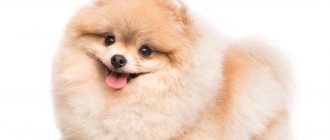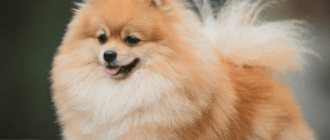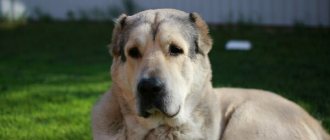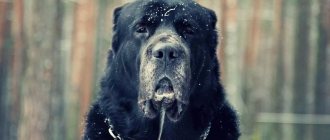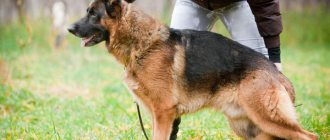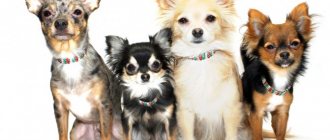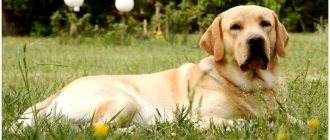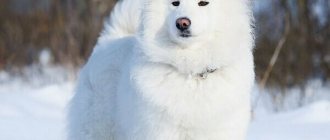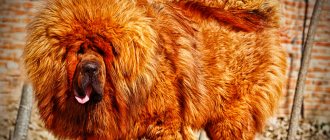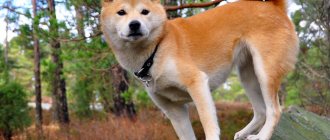The Tibetan Mastiff dog breed is one of the largest breeds in the world. A voluminous head, a powerful body, developed muscles of the limbs, enormous weight, a long life expectancy - these dogs have these features. Today we will talk about the main parameters of the standard of this breed: height, color, proportions and others.
The Tibetan Mastiff breed standard includes the following standards:
- general appearance and basic proportions;
- temperament;
- head;
- frame;
- limbs;
- movements;
- wool cover;
- color;
- dimensions: height, weight;
- defects and vices.
Some owners, in addition to the basic parameters of the standard, may be interested in how long a Tibetan Mastiff dog lives. Her average life expectancy is fourteen years. Under good conditions, the lifespan of such a pet can reach sixteen years, or even more.
General appearance and basic proportions
The Tibetan Mastiff is one of the largest dogs in the world, having enormous weight, quite impressive height and well-developed muscles. Impressive appearance, serious look, powerful jaw - when you meet this animal you feel uneasy. None of the modern breeds in the world have the same body structure.
One dog contains the best working qualities: masculinity, strength, endurance, the ability to perform its duties in various weather conditions. One of the characteristics of Tibetan mastiffs is that they reach puberty quite late:
- females - at two to three years;
- males - at four years.
Breeding: heat, how many puppies does she give birth to?
The first menstrual cycle in a female dog occurs at eight months of age and is repeated once a year, most often in late autumn. The animal's immunity weakens, and it requires special attention and care: the fur should not be allowed to get wet and hypothermia. The first mating can be done only at more than two years of age. The gestation period usually lasts between 54 and 66 days. At this time, the dog is especially aggressive and only allows its owners to approach it. Childbirth is slow. In one litter, the bitch produces offspring of 5-12 cubs, which are born almost bald.
Head
Tibetan Mastiffs have a heavy, voluminous and strong head. An adult may have folds between the eyes and the corners of the mouth.
The massive skull is rounded at the top and ends in a square shape at the bottom. The transition from the forehead to the muzzle and the bump on the back of the head are very clearly visible. The distance from the occipital protuberance to the stop (the transition from the muzzle to the forehead) is equal to the distance from the stop to the nose. Although in some cases the muzzle may be slightly smaller.
Ideal powerful jaws have a scissor or level bite with a close-set, full set of teeth. Pronounced lips cover the lower jaw.
Wide-set eyes should be medium in size, oval in shape and slightly slanted. The eyes of a dog of this breed have a proud and impressive expression. The eyelids are in very close contact with the membrane of the eyeballs.
At the level between the eyes and the skull there are pendulous ears, triangular in shape and of medium size. The ears of dogs of this breed droop slightly forward, rising when excited. They are covered with short hairs that are very soft to the touch.
The powerful neck of the Tibetan Mastiff has developed muscles and an arch shape, with small skin folds (dewlap).
Contents of the Tibetan Mastiff
Tibetan Mastiffs are dogs that require close attention, as well as compliance with a number of rules that will help maintain the physical and mental health of your pet. This series of rules includes the organization of a healthy diet, and most importantly, a balanced diet in terms of nutritional components, as well as the organization of physical activity, etc. This breed can be kept both in an apartment or a house, but also on the street, in the open air.
Care and hygiene
Since the pride of the Tibetan Mastiff is its thick coat, it requires careful care, especially during periods of shedding. It is equally important to take care of the animal’s eyes, ears, teeth and claws. That's why:
- During periods of shedding, you will have to comb the animal's fur 3 times a day.
- You will have to bathe your dog about 2 times a year.
- If tangles appear, the latter must be carefully cut out using scissors.
- You will have to brush the animal’s teeth a couple of times a week, as well as monitor the process of changing teeth and the general condition of the gums.
- Nails are trimmed twice a month with a special nail clipper.
- When returning from a walk, the animal needs to thoroughly wash its paws.
- The ears are inspected and wiped with damp sanitary wipes.
- The eyes are washed from time to time with an infusion of medicinal chamomile.
Interesting to know! To choose a worthy pair for your pet, it is advisable to contact nurseries that practice breeding a similar breed. This will not cause deviations in breed standards and will contribute to the further development of the breed.
It is also necessary to know that this breed matures relatively late, so individuals older than 4 years should be bred.
What to feed
The well-being of the Tibetan mastiff and its longevity depend directly on proper feeding of the animal. In this case, the animal can be fed both natural food and ready-made dry food. As a rule, mixing these two types of nutrition is strictly not recommended.
As experts recommend, it is better to give preference to natural food. A puppy under 2 months of age is fed 6 times a day, distributing food proportionally. The main types of foods that can be fed to a mastiff include:
- Lean meat, such as turkey or beef.
- By-products must be thermally processed.
- Fermented milk products, in the form of kefir, cottage cheese or acidophilus mixture.
- Cereals such as rice or buckwheat.
- Boiled eggs, no more than 2 per week.
- Boiled vegetables such as carrots, cabbage or pumpkin.
- Fresh fruit, including apples.
- Vegetable oil of any origin.
- Dried fruits, cheese and raisins are used to encourage the training process.
- Various greens.
You need to know this! The animal's daily food intake is about 4 percent of the animal's weight.
To balance the diet, vitamin and mineral complexes should be added to the food. Their use must be agreed with a specialist. From 2 months to 6 months of age, the animal is fed 5 times a day. At the same time, you can introduce boiled fish into your diet, removing the bones from it.
Diseases and breed defects
The Tibetan Mastiff breed is susceptible to a number of infectious diseases. For example:
- Nervous plague.
- Parvovirus enteritis.
- Rabies.
- Infectious hepatitis.
If you get the necessary vaccinations in a timely manner, you will be able to protect your animal from many dangerous ailments by protecting its immunity. Diseases associated with the characteristics of the breed are: hip dysplasia, malignant neoplasms and allergies. This can also include osteochondritis, bone dystrophy and dermatitis. Any deviation from accepted breed standards is associated with deficiencies, and their degree depends on the level of possible deficiencies.
Breed defects are associated with manifestations of various inconsistencies, not only of a physical nature. For example:
- Light or excessively wrinkled scalp.
- Saggy lips.
- The presence of a clearly visible suspension.
- Large or not too high set ears.
- The eyes are light with a wide open look.
- The nose is not brightly colored enough.
- Barrel-shaped rib part of the body.
- The tail is curled tightly at the hip area.
- Heavy and too constrained movements.
- Short stature beyond established standards.
Overly aggressive or overly indecisive individuals, or with an incorrect bite, are not allowed to be shown. The same applies to dogs that have a non-standard body color. Dogs with obvious breed deviations from the standards are also subject to exclusion.
Education and training
A dog of this breed needs early, mandatory education, which is associated with adaptation processes. Animal training is related to:
- With mandatory socialization.
- With imprinting.
- With the study of a mandatory training course.
The course of socialization and raising a puppy is associated with possible difficulties, since the puppy often shows stubbornness and aggression. This is due to the peculiarities of the animal’s behavior, due to the mastiffs’ sense of self-esteem.
Important to remember! After the imprinting course has been mastered, you should begin the stage of socialization of the animal. This stage is associated with the animal learning to adequately respond to the world around it and to human society. A socialized animal can easily learn the entire course of basic training and commands.
Imprinting is the process by which a dog begins to trust its owner. Such training, associated with the first stage of education, teaches the dog to react correctly to surrounding events, including to humans.
Tibetan Mastiff #1.// Ideal dog. The best watchman.
Frame
The powerful body of a dog of this breed consists of a muscular back and a straight line of the spine. The croup is voluminous, flat in shape. The deep chest of medium volume reaches the elbow joints, the bend of the compressed ribs resembles the shape of a heart. The body length of the Tibetan Mastiff is slightly longer than its height.
The Tibetan Mastiff's tail is of medium length and high set. It is located at the level of the straight line of the spine. When alert or excited, the animal raises its tail quite high, easily throwing it over its back.
Limbs
The straight forelimbs have an ideal angle of articulation, that is, the elbow joints are not turned in different directions. Forearms are straight. Powerful pasterns should have a slight slope.
The hindquarters are well-muscled, with well-bent knees and powerful, low hocks. If you look at the hind legs from behind, you can see that they are parallel to each other. The thighs are of moderate length and well developed.
The compact, rather long paws of the Tibetan Mastiff should be round in shape and with slightly curved toes. According to the standard, dogs of this breed are allowed dewclaws.
How to measure height correctly?
To correctly measure height, you first need to find the dog's withers. The withers is the section of the body where the lowest point of the neck and the slope of the shoulder blades meet.
If it is difficult for you to immediately determine by eye where this part is located, then there is a method that will help:
- Place your hands on the dog's shoulders and press them to the body;
- Start moving your hands upward, pulling the skin until you have a fold in your hands;
- Lower your arms so that they rest on your shoulder blades;
- The skin that remains in your hands is the fold located at the withers and behind the nape.
Once the withers have been located, it is time to measure the dog's height.
It is necessary to measure a dog's height at the withers.
This is due to the fact that the neck and head posture of dogs of the same breed may be different.:
- Place your pet in a stand. This is specially taught to show dogs. If your dog does not know how to do this, then you can see him at the moment when he is watching something. The position of the head and neck is not taken into account;
- The dog must stand on a flat surface;
- To prevent him from being distracted by you, interest him in his favorite toy or treat;
- If the dog is constantly trying to leave, jumping and fussing, then it is wiser to measure the back;
- If the dog is standing calmly, then measure the height at the withers using a tape measure or ruler.
Coat
For the Tibetan Mastiff, the quality of the hairs is more important than their quantity. Bitches have fewer of them than males. The outer coat of medium length consists of an undercoat (dense, rather thick) and guard hairs (thin, sticking out, hard to the touch). The coat should not have any waves or curls. Also, it cannot be silky and soft to the touch.
A luxurious mane, similar to a lion's, abundantly covers the neck and shoulders of the Tibetan Mastiff. The animal's tail is well furred. The upper part of the hind legs is covered with a kind of “pants”.
Color
You can find Tibetan Mastiffs with coat colors such as:
- black;
- black and tan;
- blue;
- blue and tan;
- golden (from fawn to rich red);
- sable
The intensity of tan marks varies from dark brown to reddish. Markings may be in the area of the upper part of the eyes, on the paws, or on the tail. Despite the markings, any coat color in dogs of this breed should be clear, without blurring. White color is acceptable in the chest area in the form of a small spot, as well as in the lower parts of the limbs.
Depending on the coat color, the Tibetan Mastiff's eyes may have a brown tint. According to the standard, the darker the eye color, the more preferable it is. Nose is black. Lips are black. The absence of black pigmentation in these places is considered a flaw.
Departing from the standard parameters, it is worth noting that the rarest dog of this breed is the white, unspotted Tibetan Mastiff. There are very few of them in the world, as there are great difficulties with breeding. Because of this, the standard does not accept this color.
However, an individual with this coat color is the most expensive among the rare breeds in the world. Its cost can reach one million dollars.
Breed Features
Tibetans are very loyal and devoted pets. If the owner has established a spiritual connection with his pet, he will receive the most obedient companion who will be happy to spend time with him and engage in active games and sports.
Important! Mastiffs are very friendly and affectionate towards their family members. Even with small children, they often start fun games. However, they can be wary of strangers.
Pets will not show excessive aggression; they only get angry in response to attacks in their direction or towards the owner. But the dog’s intimidating look and tense posture will indicate that it reliably protects its people.
Mastiffs were bred in the mountains of Tibet and have lived there for many centuries. Throughout the history of its formation, the breed has remained virtually unchanged in appearance. At first they were used by monks for herding livestock. For many years, dogs have been trained to make their own decisions. Today this is a bit of a hindrance in training Tibetans.
Dimensions
The height of Tibetan Mastiff males starts from 66 cm, the height of females - from 61 cm. The weight of males varies from 72 kg to 80 kg, the weight of females - from 60 kg to 75 kg. The weight of the largest dogs of this breed can reach ninety kilograms, or even more.
Let's move away from the norms of the standard. Interesting information: the official registration of canine records recorded the fact that the world's largest dog of this breed weighed 113 kilograms.
However, some experts of the breed claim that the largest representatives of this breed already existed in the world. For example, the weight of the largest Tibetan mastiff named Lio Chang, who lived in the twentieth century, was 155 kilograms.
